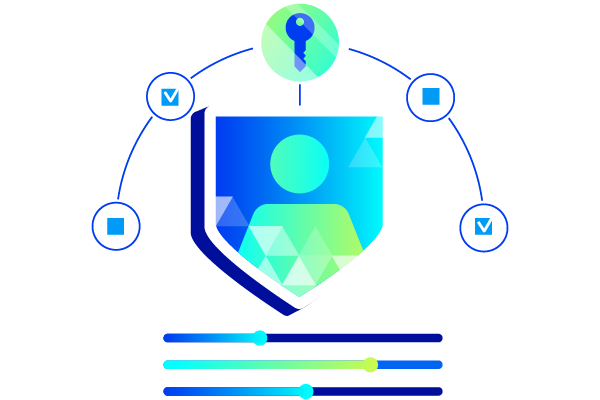What is CIAM?
Defining CIAM
Within identity and access management (IAM), customer identity and access management (CIAM) is a specialised discipline focusing on managing the account identities of external users, which, for many organisations, are primarily their customers who access their customer data.
CIAM security platforms provide the essential security functionalities of registration, authentication, and authorisation, ensuring secure access to digital resources while maintaining a frictionless user experience.

These user management capabilities empower administrators to exercise strict control. That includes over-access rights in assigning roles and generally managing user profiles efficiently. Some CIAM solutions even come with self-service portals enabling an organisation’s customers to independently manage their profiles, preferences, and security settings.
In some ways, CIAM is similar to other IAM security solutions, which inherently include customer access control. However, a key differentiator of CIAM is its emphasis on the customer experience, also known as CX.
Customer identity and access management solutions should prioritise personalised and seamless cybersecurity across all touchpoints in the customer journey across organisations. CIAM can do this because it leverages customer data and preferences to tailor the identity experience: never asking for too high a verification level nor requesting too little, risking security objectives.
Contrast with Employee IAM
A CIAM application shares some similarities with traditional employee security Identity and Access Management (IAM) applications. However, the customer information management principle remains the same: ensuring that only authorised users gain access to an organisation’s systems.
Yet, there are a couple of distinct differences for organisations. To start off with, CIAM caters to a much larger and more diverse customer data user base: we’re talking about a list of customers that could even be in the millions, compared to employees who might be a few thousand—nothing near as many as customers.
Customers are also generally less technically proficient, and isn’t the first thing they consider. Therefore, CIAM use cases need to be able to scale and handle varying levels of customer technical proficiency; in other words, the authentication use case should be simple.
Additionally, given the huge number of people involved at the time, a CIAM solution needs to place a stronger emphasis on customer self-service capabilities because it can be tough to send customer support information requests for each customer when the user base is that large.
Privacy considerations also matter more with CIAM, which, in some ways, means that authentication needs to be much tighter.
Extensive Scope
CIAM goes beyond simple security login functionalities and encryption. It encompasses features like preference management, allowing users to customise their experience and receive personalised content.
Consent information management tools ensure compliance with data privacy regulations by obtaining and managing user consent for data processing. Single sign-on (SSO) capabilities streamline the customers' user experience by allowing customers to access multiple applications or services with a single set of credentials.
Given an organization's vast number of potential users, security scalability is a crucial consideration for CIAM platforms. They must be able to accommodate fluctuations in user traffic and adapt to varying loads without compromising performance or security.
Additionally, customer identity and access management users' use cases must be flexible enough to support diverse customer data, ranging from simple website logins to complex multi-channel interactions across various devices and platforms.
The Evolution of CIAM
The evolution of CIAM sign-on has been mainly due to the practical limitations of legacy Identity and Access Management (IAM) solutions. Traditional IAM systems, designed primarily for employee access, were often fragmented, inflexible, and ill-suited to handling the unique requirements of managing customer identities.
Legacy sign-in systems lacked the customization options and user-centric features necessary to meet the demands of modern users, who expect simple access to online products and services.
Digital transformation for customers is another catalyst for the evolution of CIAM. Everyday interactions are going online increasingly, so customers expect seamless and personalised interactions to become paramount, including when they log in.
Customers and users expected convenient access to services, tailored experiences, and the ability to independently manage their preferences and data. Traditional IAM use cases could not deliver on these high UX and privacy expectations, which meant that many organizations started using specialized CIAM sign-on platforms to manage identity and access for their customers.
Data Privacy and Security Concerns
Another major contributor is the sheer volume of customer information collected and stored online. Data privacy and security concerns have become a central focus for businesses, which in turn means that access control needs to tighten security, including for customers who intend to use a site for online tasks.
The introduction of stringent data privacy regulations like the General Data Protection Regulation (GDPR) and the California Consumer Privacy Act (CCPA) meant that robust CIAM solutions were no longer an optional choice at this time.
CIAM goes beyond IAM sign-on solutions by offering much more focus on data protection help and compliance information. A modern CIAM platform is also simply better at consent management and data anonymization. While IAM offers encryption, CIAM goes further in safeguarding customer data and ensuring adherence to regulatory requirements.
Consumer Expectations
Consumer and user expectations have played a significant role in shaping the evolution of customer identity and access management. Customers now demand convenient, secure, and personalized access. This expectation is pervasive, too, covering all digital services across various devices and platforms.
Users are also expected to have frictionless experiences. Self-service account information capabilities for managing profiles and preferences are key, along with some say over security settings.
CIAM sign-on platforms have responded to these expectations by offering user-friendly interfaces and streamlining the UX for registration and authentication processes.
What is the Business Case for CIAM?
It’s not entirely a matter of choice. Companies must consider CIAM rather than considering it an optional tool. A strong CIAM sign-on solution is instrumental in improving customer acquisition and retention rates.
The seamless and personalised account information registration and login UX of a good CIAM solution means that companies reduce friction and increase the likelihood of customers completing transactions – rather than abandoning a shopping cart.
Self-service portals and preference management empower customers, a substantial step ahead of blunt IAM tools.
Reduced Fraud and Security Risks
Possibly the most critical aspect of CIAM sign-on is how it helps admins mitigate identity fraud and security risks. Just like IAM, a good customer identity and access management platform will deliver robust authentication mechanisms, such as multi-factor authentication (MFA) and risk-based authentication. These add more layers of security to protect customer accounts from unauthorized access.
CIAM can also provide proactive security measures and monitor user behavior. Thanks to these powerful aspects of CIAM, businesses can detect and prevent fraudulent activities.
Benefits For Customers
As often is the case, what benefits business applications also benefits the customer. By prioritising a positive and seamless customer experience, businesses can significantly improve customer acquisition and retention rates.
CIAM helps companies to streamline their registration and to make overall authentication experiences more personalised.
Moreover, CIAM sign-on solutions help play a vital role in protecting customers' account identities from fraud and security risks. Here, customers can remain sure that their account identities are safe from intruders. This can be essential when businesses provide e-commerce or e-money platforms, where any account intrusion can lead to substantial losses.
Good CIAM platforms also provide a wealth of customer data that can be leveraged to gain valuable insights and inform business decisions.
Best Practices for Successful CIAM Implementation
Like IAM, customer identity and access management are great tools for increasing security. Conversely, poorly implemented CIAM sign-on can be frustrating for users. Implementing a successful CIAM sign-on solution requires a thoughtful and strategic approach to identities. Here are some best practices to consider:
Prioritize user experience
A seamless and intuitive application user experience is paramount. Simplify registration and login processes, offer self-service options, and provide clear instructions and support resources.
Security by design
Security should be a fundamental consideration from the outset. Implement strong authentication mechanisms like MFA, regularly audit and update security protocols, and encrypt customer data at rest and in transit.
Data minimisation
Only the necessary data is collected to minimise privacy risks and comply with data protection regulations when building applications. Implement robust consent management mechanisms to give customers control over their data.
Scalability and flexibility
Choose a CIAM solution that can scale to accommodate a growing user base and adapt to evolving business needs. Ensure the platform can integrate with your existing systems and applications.
Continuous monitoring and improvement
Regularly monitor and analyse user behaviour, security logs, and system performance to identify potential issues and areas for improvement. Stay updated on emerging security threats and update your CIAM solution accordingly.
It’s also worth taking the time to educate your customers about the digital login benefits of CIAM for their identities, how their data is protected, and how they can manage their preferences and security settings.
Maintain open communication and provide prompt support to address any concerns or issues they may have.
Addressing Modern Identity Management Challenges
As data privacy regulations like GDPR and CCPA become increasingly stringent, businesses must ensure their customer identity and access management solutions help them fully comply with digital login regulations.
We will likely see these regulations increase, so a CIAM sign-on solution should be flexible enough to meet changing regulatory expectations. This involves implementing consent management, data anonymisation, and encryption to protect customer data and avoid legal repercussions.
CIAM platforms must also provide robust digital login audit trails and reporting capabilities to demonstrate compliance with regulatory bodies.
Meeting UX Expectations
That said, the other evolving aspect of CIAM account sign-on is customers' constantly increasing expectations of a minimally viable user experience.
Whether users access a service from a desktop computer, smartphone, or tablet, CIAM solutions must be designed to deliver consistent user experiences regardless of the device or platform used.
This requires responsive design, adaptive authentication methods, and seamless data synchronisation across digital login touchpoints.
Social logins are another important point. Logging in using social media accounts has become a popular way for users to access online services, as they eliminate the need to create and remember new passwords. CIAM platforms must integrate with popular social media platforms.
The Future of CIAM
As artificial intelligence (AI) and machine learning (ML) mature, CIAM solutions will become more intelligent. They will be capable of analysing vast amounts of identity data to provide even better security, as AI detects malevolent login attempts.
The rise of the Internet of Things (IoT) will also impact customer identity and access management as more devices and objects become interconnected. CIAM solutions must adapt to help manage and secure account identities across various IoT devices, ensuring seamless and secure interactions.
Furthermore, the increasing focus on identity data privacy and regulations will continue to shape the future of CIAM. Solutions must incorporate privacy by design principles, ensuring that data is collected and processed responsibly, with user consent and control at the forefront.
OVHcloud and CIAM

Through our user and role management solutions, OVHcloud emphasizes security and DevOps. We offer various digital login mechanisms to protect user accounts. We support standard protocols such as OAuth 2.0 and OpenID Connect, allowing for secure and seamless authentication across different applications.
We also offer two-factor authentication (2FA) options to add an extra layer of security to user accounts.
OVHcloud Identity and Access Management Solutions is a comprehensive identity and access management solution that allows you to securely manage users, applications, and their permissions across all your OVHcloud services.
We give you a single interface for managing digital logins to all OVHcloud products, including VMware on OVHcloud, OpenStack, and third-party software.
OVHcloud IAM lets you easily connect your corporate directory for seamless authentication and manage fine-grained access policies based on roles, responsibilities, and resource types. You can also rely on OVHcloud for broader cloud project management solutions.